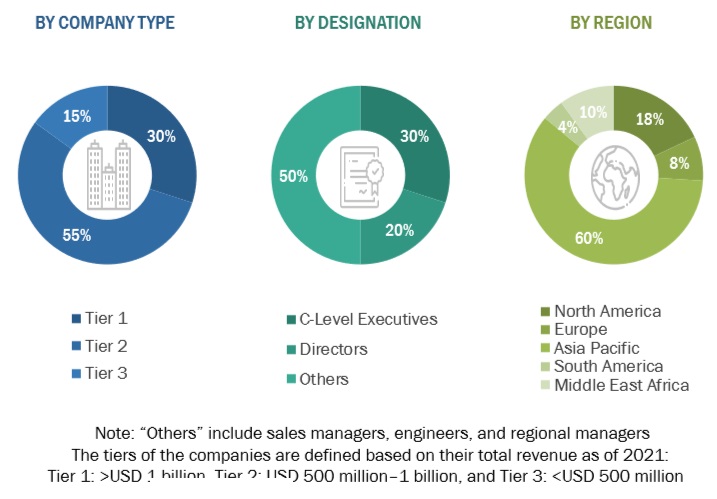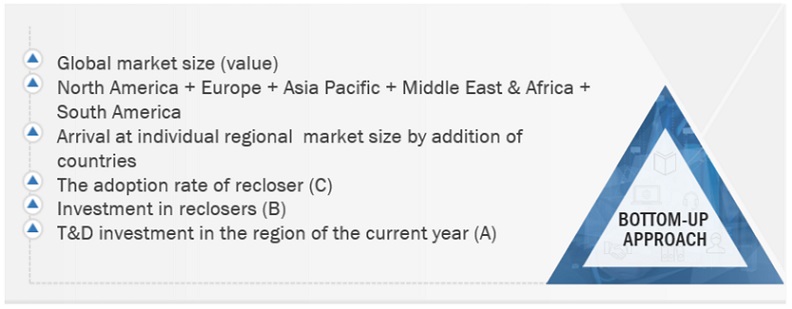This study encompassed significant efforts in determining the present size of the recloser market. It commenced with a thorough secondary research process to gather data related to the market, similar markets, and the overarching industry. Subsequently, these findings, assumptions, and market size calculations were rigorously validated by consulting industry experts across the entire supply chain through primary research. The total market size was assessed by conducting an analysis specific to each country. Following that, the market was further dissected, and the data was cross-referenced to estimate the size of various segments and sub-segments within the market.
Secondary Research
In this research study, a wide range of secondary sources were utilized, including directories, databases, and reputable references such as Hoover's, Bloomberg BusinessWeek, Factiva, World Bank, the US Department of Energy (DOE), and the International Energy Agency (IEA). These sources played a crucial role in gathering valuable data for a comprehensive analysis of the global recloser market, covering technical, market-oriented, and commercial aspects. Additional secondary sources included annual reports, press releases, investor presentations, whitepapers, authoritative publications, articles authored by well-respected experts, information from industry associations, trade directories, and various database resources.
Primary Research
The recloser market involves a range of stakeholders, including component manufacturers, product manufacturers/assemblers, distributors, and end users within the supply chain. The demand for this market is primarily driven by end users such as transmission and distribution utilities, commercial and residential sectors, and industries. Additionally, the increasing demand from railways and metros contributes to market growth. On the supply side, there is a notable trend of heightened demand for contracts from the industrial sector and a significant presence of mergers and acquisitions among major players.
To gather qualitative and quantitative insights, various primary sources from both the supply and demand sides of the market were interviewed. The following breakdown presents the primary respondents involved in the research study.

To know about the assumptions considered for the study, download the pdf brochure
Market Size Estimation
The estimation and validation of the recloser market size have been conducted using a bottom-up approach. This approach was rigorously employed to ascertain the dimensions of multiple subsegments within the market. The research process comprises the following key stages.
-
In this method, the production statistics for each type of recloser have been examined at both the country and regional levels.
-
Thorough secondary and primary research has been conducted to gain a comprehensive understanding of the global market landscape for various segments of reclosers.
-
Numerous primary interviews have been undertaken with key experts in the field of recloser development, encompassing important OEMs and Tier I suppliers.
-
When calculating and forecasting the market size, qualitative factors such as market drivers, limitations, opportunities, and challenges have been taken into account.
Global Recloser Market Size: Bottom-Up Approach

To know about the assumptions considered for the study, Request for Free Sample Report
Data Triangulation
The process of determining the overall market size involved the methodologies described earlier, followed by segmenting the market into multiple segments and subsegments. To finalize the comprehensive market analysis and obtain precise statistics for each market segment and subsegment, data triangulation and market segmentation techniques were applied, as appropriate. Data triangulation was accomplished by examining various factors and trends from both the demand and supply perspectives within the ecosystem of the recloser market.
Market Definition
In the power distribution industry, a recloser can be defined as an automatic circuit interrupting device specifically designed for medium voltage applications. Unlike traditional circuit breakers requiring manual intervention, reclosers are equipped with sensors that detect faults on the power line. Upon detecting a fault, they automatically interrupt the current flow using an arc quenching mechanism, typically oil or a vacuum. However, a key distinction sets reclosers apart: they incorporate an automatic reclosing sequence. This attempts to re-energize the line after a pre-programmed timeframe, aiming to clear temporary faults while isolating persistent ones. This automated process minimizes outage durations for unaffected customers on healthy phases of the line. Reclosers are strategically placed within medium voltage distribution networks, typically ranging from 15 kV to 38 kV. Their deployment can be found on distribution feeders, overhead lines, and even within substations where they work in conjunction with other switchgear for comprehensive protection.
Key Stakeholders
-
Government and research organizations
-
State and national regulatory authorities
-
Organizations, forums, alliances, and associations
-
Institutional investors
-
Investors/shareholders
-
Environmental research institutes
-
Integrated device manufacturers (IDMs)
-
Recloser raw material and component manufacturers
-
Recloser manufacturers, dealers, and suppliers
-
Power utilities and other end users
-
Consulting companies in the energy and power domain
-
Investment banks
Objectives of the Study
-
To describe and forecast the recloser market, in terms of value, by phase, control type, voltage rating, insulation medium, and region
-
To forecast the recloser market, in terms of volume, by voltage rating
-
To forecast the market for various segments, in terms of value, with regard to five regions: North America, South America, Europe, Asia Pacific, and the Middle East & Africa, along with their key countries
-
To provide detailed information about the key factors, such as drivers, restraints, opportunities, and challenges, influencing the market’s growth
-
To strategically analyze the subsegments with respect to individual growth trends, prospects, and contributions of each segment to the overall market size
-
To study the complete supply chain and allied industry segments and perform a supply chain analysis of the recloser landscape
-
To strategically analyze the regulatory landscape, tariff, standards, patents, Porter’s five forces, import and export scenarios, trade values, and case studies pertaining to the market under study
-
To analyze the opportunities in the market for various stakeholders by identifying the high-growth segments of the recloser market
-
To profile the key players and comprehensively analyze their market position in terms of ranking and core competencies1, along with detailing the competitive landscape for the market leaders
-
To analyze competitive developments such as agreements, partnerships, product launches, acquisitions, contracts, expansions, and investments in the recloser market
Available Customization
With the given market data, MarketsandMarkets offers customizations based on the company’s specific needs. The following customization options are available for the report:
Product Analysis
-
Product Matrix, which provides a detailed comparison of the product portfolio of each company
Company Information
-
Detailed analyses and profiling of additional market players (up to 5)



VITZRO
Jun, 2019
Could you please let us know the Recloser Market, By Voltage: Up to 15 kV; 16–27 kV; 28–38 kV. How much percentage each?.